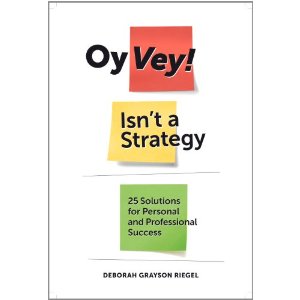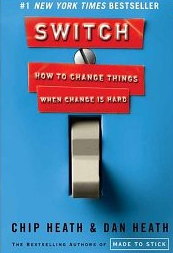I have three stacks of books by my bed: the professional reading, the personal reading (parenting books, etc.) and the ‘for fun’ reading (novels, biographies, etc). The urgency usually follows that order, to the point that my last new years’ resolution was to read more fun novels. It’s July. The end of July. I have read exactly 1.
So it’s a good thing I picked up Deborah’s book, Oy Vey Isn’t a Strategy. The book was officially in the first pile: professional reading. Though it very well could have been in the second (striving for better work/life balance, personal satisfaction, etc.). About 2 pages in I realized it was entertaining enough to qualify for the “just for fun” pile too. This woman is a hoot! This book really transcends any category, or perhaps better put, it delivers value in all of them.
Deborah puts so much of herself into this book. In some places it reads like a memoir, and knowing Deborah, I have fully enjoyed getting to know her better through her amazing personal, familial and professional stories. We can all see a bit of ourselves in her journeys and reflections.
But the real punch of the book is that Deborah uses her own entertaining stories (and delightfully funny writing style) to hold up a mirror for us to see, and understand, ourselves – personally, professionally, emotionally, strategically.
I cracked the book on an airplane that was already running hours late on a flight home from Chicago. We were taking off at 10pm. I’d arrive home in the wee hours of the morning. I intended to peruse the first chapters and then sleep, but I could not but this book down. By the time I got to chapter 8 (which begins, “Temporarily losing my left eyebrow changed me permanently…”) I had given up sleep and found myself giggling out loud (apologies to the gentleman reading a neuroscience journal in 9B next to me).
But within a few pages in every chapter, Deborah seamlessly moves from the upturn of my smile to the depth of my heart and gut, gently and firmly holding and articulating the issues that are at the root of our happiness and success. And just to make sure that the ideas and reflections don’t end in our heads, each chapter ends with questions and exercises to help us really knead our own experiences and apply her teachings to our own lives.
The most insightful nuggets of this book sometimes are delivered in insightful one liners. It’s full of them. My favorite? In chapter 14 Deborah observes that for many of her clients seeking help as ‘self diagnosed procrastinators’, “we discover that procrastination is masking perfectionism”. BULLSEYE. While I don’t find that I’m a serial procrastinator, this is exactly why it does occasionally happen. And that procrastination can be costly – in time, energy, dollars, relationships, and attention wasted elsewhere. Small lessons can have big impact. And this book is full of them.
My ‘personal reading’ stack includes many Jewish books. While I work with rabbis and Jewish educators everyday, I’m always wishing I could make more time for my own Jewish learning. And, as if Oy Vey hadn’t delivered enough yet, the Jewish lessons, quotes and stories are woven throughout. Deborah’s lessons for us are grounded in experience, training, wisdom, thoughtfulness, and tradition. And when I was done, exhausted and travel weary, I felt grounded too.


 Rabbi Hayim Herring (of STAR: Synagogues Transformation and Renewal) and the visionary behind Synaplex) has recently published a new book: Tomorrow’s Synagogue Today. You should read it, and buy a copy for the senior staff and every board member of your synagogue.
Rabbi Hayim Herring (of STAR: Synagogues Transformation and Renewal) and the visionary behind Synaplex) has recently published a new book: Tomorrow’s Synagogue Today. You should read it, and buy a copy for the senior staff and every board member of your synagogue.  But the flip side of all of this is the narrowing of our worlds.
But the flip side of all of this is the narrowing of our worlds. 

 ou’re looking for the gift that keeps on giving, right? I’ve got just the thing for you. Pick up a copy of Beth Kanter and Allison Fine’s book
ou’re looking for the gift that keeps on giving, right? I’ve got just the thing for you. Pick up a copy of Beth Kanter and Allison Fine’s book  I am currently re-reading
I am currently re-reading 